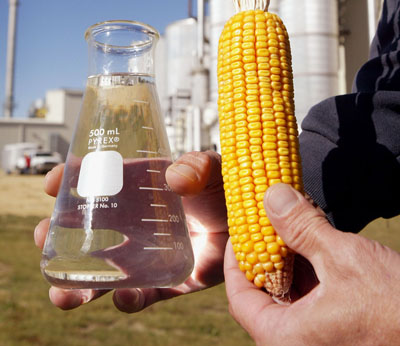Ethanol is high-octane and clean-burning fuel that can be made from various renewable sources. E85 reduced dependence on exhaustible fuel sources derived from crude oil. E85 ethanol is made from 15 percent gasoline and 85 percent pure ethanol. It can be used on trucks and automobiles. Ethanol can be made from various organic sources, such as sugar cane, wheat, potatoes, rice and others. In many cases, ethanol should reduce the overall fuel cost, because ethanol is cheaper than unleaded gasoline. The harmful emission of regular gasoline can also be reduced. There are different amounts of ethanol that can be mixed with gasoline. Ethanol is already available in many places and it is quite easy to produce with moderately advanced technology.
Other than E85 fuel, we may also find E10 in the market and it is made of 90 percent unleaded gasoline and 10 percent ethanol. E10 is also known as gasohol and it is usable for many cars without any significant modification. Among cleaner fuel options, E10 is one of the more recommended. It offers cleaner burning characteristic and reasonably high performance, compared to standard unleaded gasoline. Today, we can find many gasoline types that are mixed with ethanol, especially in developed countries. Flexible fuel vehicles are able to use different levels of ethanol-mixed fuel, including E85. There are already many FFV in the market and it is a good idea to choose one if we plan to purchase a new car. These cars should also support pure unleaded gasoline or fuel with higher ethanol content.
In many cases, we don’t need to perform any change on the engine. E85 is essentially a less-toxic fuel and it can be handled more safely. Even during massive spill over, the cleanup process is much easier to do. Since ethanol can be produced rather easily, the overall transportation requirements will be significantly reduced. In reality, ethanol-burning vehicle isn’t a new technology. Henry Ford built the quadricycle in the 1880’s and it used ethanol as fuel. The carburettor of Ford Model T has a switch between Ethanol and Gasoline. Today, many environmentalists prefer the use of ethanol, because the risk of pollution can be significantly reduced. Compared to gasoline, the emission of greenhouse gasses is much reduced with ethanol.
The actual carbon footprint of ethanol burning is actually very low, because the plant will absorb more carbon dioxide to create the same amount of energy. One of the problem is the use of agriculture machines that are often powered with dirtier diesel fuel. However, more and more machines are using ethanol-based fuel, making the whole process cleaner. Many countries already have millions of ethanol-powered cars on the road. Brazil has produced a significant quantity of ethanol from sugar cane that is available produced in huge quantity. By using sugar cane, the country no longer has significant money outflow for purchasing refined gasoline for domestic cars. Multiple militaries have also studied the use of green fuel for their routine operations. However, the problem is still the lack of availability in remote areas.
























